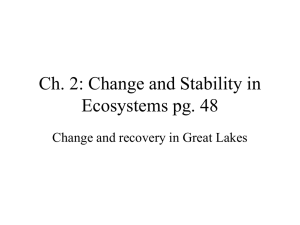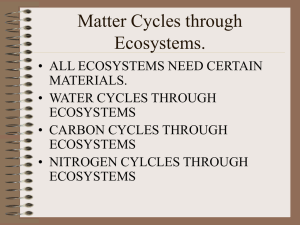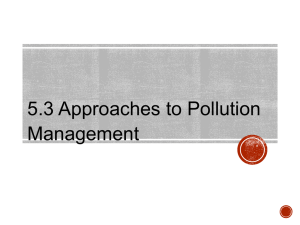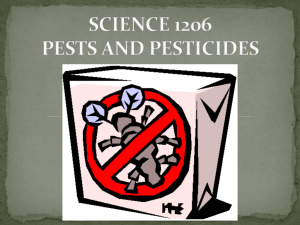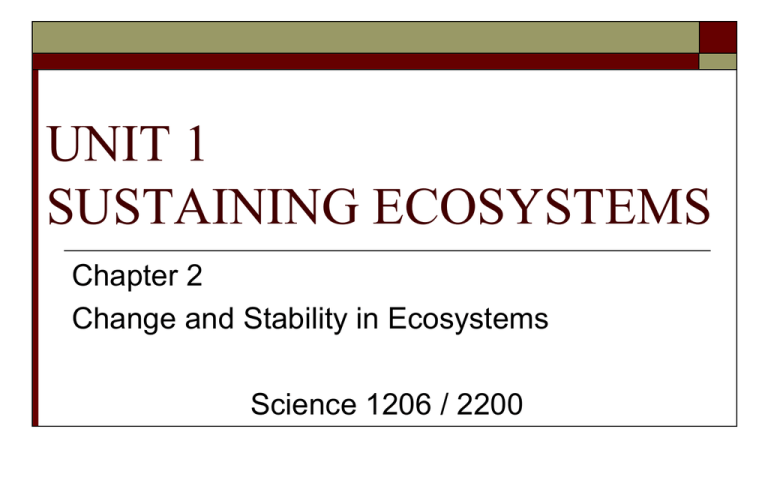
UNIT 1
SUSTAINING ECOSYSTEMS
Chapter 2
Change and Stability in Ecosystems
Science 1206 / 2200
Change & Recovery in Ecosystems
What happens to the
materials that make up
a truck when it begins
to rust?
What happens to the
tree after it dies?
2.1 - Cycling of Matter in Ecosystems
Organic substances
Contain atoms of Carbon and
Hydrogen
Are broken down into simpler
forms in living things
Ex. Sugar, carbohydrates,
proteins, amino acids
Inorganic substances
Does not contain combination of
carbon and hydrogen
Ex. Water (H2O), ammonia
(NH3), Carbon dioxide (CO2)
Biological Processes Involved in Nutrient
Cycling
1.
Photosynthesis
Plants convert CO2 and H2O into O2 and sugar
6CO2 + 6H2O + energy → C6H12O6 + 6O2
2.
Respiration
Animals AND plants use O2 and sugar,
converting it to CO2 and H2O
C6H12O6 + 6O2 → 6CO2 + 6H2O + energy
More Processes
Decomposition
3.
•
•
Remains of dead organisms are broken down by bacteria
and fungi
All molecules are released into soil
Excretion
4.
•
Waste material from animals is broken down and
returned to the soil
Assimilation
5.
•
•
Conversion of molecules into a useable form by bacteria
Nitrification, denitrification
Cycling of Organic Matter
The atoms and molecules
available to make up organisms
on earth is limited
All the atoms MUST be recycled
in order for new organisms to
form.
It is very likely that at least one
of the carbon atoms in your body
was also in a 70 million year old
dinosaur
Recycling of Matter by Micro-organisms
The Matter Cycle
1.
Dead plants and animals are broken down
by decomposers – their atoms / molecules
are released into the system to be re-used
2.
Atoms, molecules accumulate in the soil
3.
Nutrients are taken up by grasses
4.
Cows eat the grass – nutrients and atoms
are passed on to the cow
5.
Person eats cow – nutrients and atoms are
passed on to person
6.
Each of these things can die, the atoms are
broken down by decomposers and
recycled for the next living things
Soil
Decomposers
Person
Grass
Cow
The Oxygen Cycle
Respiration:
C6H12O6 + 6O2 6CO2 + 6H2O + energy
Photosynthesis:
6 CO2 + 6 H2O + light C6H12O6 + 6O2
What do you notice about these two chemical
reactions?
The Oxygen Cycle
Oxygen
(in atmosphere)
PHOTOSYNTHESIS
by green plants
Combustion
(burning stuff)
Carbon Dioxide
(in atmosphere)
RESPIRATION
by plants, animals
and decomposers
The Carbon Cycle
CO2 in the atmosphere
Photosynthesis - carbon
is stored in the biomass
Glucose
volcanic
eruption
Aerobic
respiration
Decomposition
Weathering
Conversion to fossil fuels
CO2
dissolved in
water
combustion
Ocean
sediment
Fossil fuels
The Carbon Cycle
Two groups of carbon sources in the
carbon cycle
1.
2.
Biotic - Aerobic respiration (in the presence of
O2), and decomposition
The organic reservoirs (storage areas) for
carbon are the bodies of living things
Abiotic - Combustion and geological activity
The inorganic reservoirs for carbon are
the atmosphere, the oceans, and the
Earth’s crust
The Nitrogen Cycle
The movement of nitrogen
through the ecosystems, the soil,
and the atmosphere is called the
nitrogen cycle. Nitrogen gas
composes 79% of the Earth’s
atmosphere. In order for
nitrogen to be useful to
organisms, it must be available
as a nitrate ion (NO3-).
Atmospheric nitrogen is
converted into nitrates by the
process of nitrogen fixation, or
nitrification, either by lightning
or by bacteria in the soil
Nitrogen is required to
make proteins and
DNA which is the
genetic material found
in every cell.
The Nitrogen Cycle
The Nitrogen Cycle
Essential to living things for the production
of amino acids used to synthesize proteins,
and nucleic acids which are used to carry the
hereditary or genetic code
Plants and animals are unable to use any of
the N2 that is in the atmosphere
The nitrogen cycle can occur in both
terrestrial and aquatic ecosystems
Nitrogen Cycle
Complex cycle can be simplified as follows
plants to make use of nitrogen it must first be
converted into ammonia or nitrates (NO3-)
two pathways that produce nitrate ions:
fixation by lightning (produces nitrates directly)
fixation by bacteria (producing ammonia) followed by
nitrification by bacteria (converting the ammonia to
nitrates)
(ANIMATION)
Question
IN YOUR NOTEBOOK, ANSWER THE
FOLLOWING QUESTION
1.
What are some ways that the balance of
the carbon cycle is affected by human
activity?
The Greenhouse Effect
The cause of global warming
Excess CO2 in the atmosphere acts like a blanket
Where does the CO2 come from?
Burning of fossil fuels in factories and cars
Mining removing more carbon from the earth
Burning of rainforests clearing farmland
Destruction of rainforests reduces the number of
trees to remove the CO2
Global Warming
Describes the increase in the earth’s atmospheric
and ocean temperatures
Caused by the Greenhouse effect
Radiation reaches earth from the sun
Some is blocked by the ozone layer, some not
Heat radiation reflects from the earth back into space
CO2 and Methane (CH4) in the atmosphere absorbs
some of this heat, reflecting it back to earth
The Result The earth then gets warmer
Effects of Global Warming
General Effects
Increase in global
temperature
Effects on Ecosystems
Species forced out of habitats
(possibly to extinction)
Changes in climate
Other species may flourish
Increasing ocean levels
Decreased Ozone layer
Less snow cover = less
protection for some species
(ANIMATION)
What Are We Doing About It?
1.
2.
Reducing CO2 output
1-tonne challenge, electric/ hybrid cars
Cutting back on energy consumption
Kyoto Accord
3.
Global agreement to reduce emissions
Reducing deforestation
Nutrient Cycling, Interrupted
IN YOUR NOTEBOOK
How do you suppose human activities
affect the other chemical cycles?
Think about the effects of agriculture and
industry
Affects on Carbon & Oxygen Cycles
Eutrophication
Fertilizer runoff increases growth in water
Increased nutrient levels released into the environment
In aquatic ecosystems – Number of organisms
increases, O2 levels decrease as consumption increases
The water becomes anaerobic (no oxygen), organisms
die off
Habitat destruction & exotic species introduction
4 types of Pesticides
Herbicides kills plants
Insecticides kills insects
Fungicides kills fungi
Bactericides kills bacteria
Antibiotics
Pesticides
First Generation
Substances such as
sulfur, arsenic, lead and
mercury.
Banned usage around the
world
These are toxic to humans
so people began to use
plant extracts
Still can be found in fish
populations around the
world
Second Generation
Chemicals made in a lab
Synthetic pesticides
Not necessarily better than
the first generation
chemicals
Chemicals like DDT or
Round-Up
Bioaccumulation & Bioamplification
Bioaccumulation
Increase in concentration
of a pesticide from the
environment in all
organisms in a food chain
Often insects consuming
herbicides
Bioamplification
The higher up the food
chain, and thus the higher
the trophic level, the higher
the concentration of toxins
Top carnivores end up with
the greatest concentrations
of toxins
Figure 4 on page 54 in your book
Bioaccumulation
Bioamplification
Long-lived Present for a long time in the system
Mobile Easily passed up the food chain
Soluble in fats Dissolves in, and is stored in fatty tissue
Biologically active –
Affects biological body tissue
Bioamplification
Pesticides: Past and Present
Past Chemical Pesticides
Stored in fat tissue
Not soluble in water
Modern Chemical Pesticides
Not stored in fat tissue
Soluble in water
Pesticide Resistance
When pests become resistant to pesticides
pesticide no longer effects them
Sometimes individuals have the genetic
ability to resist a chemical. If all others die
when they are sprayed, then the survivors
are about to reproduce
A resistant population of pests is created
Resistance is Futile… Or Not
Dichloro-diphenyl-trichloroethane (DDT)
Pesticide that is suitable for
bioamplification
Meets the 4 requirements
Has a half-life of 15 years
That is, every 15 years the
amount left in the system will be
reduced by one half.
If you use 100 kg of DDT, after
15 years it will be reduced to 50
kg, and after another 15 years it
will be 25 kg, and so on.
Effects of DDT Usage in Borneo
Effects of DDT on Top Predators
Shell thinning
1.
2.
3.
Carnivorous birds such as
ospreys and bald eagles eat
other birds, dead animals
and fish which contain a
build-up of DDT
DDT causes the shells to
become too thin to allow
the large females to sit on
the eggs without them
breaking
Since eggs are being
broken, the over-all
population of these birds is
declining
After DDT was banned in
the US and Canada in the
early 1970’s the bird
populations of recovered.
DDT bioaccumulates in
humans the same as it
would other animals
Male birds have also
become more feminine as
the DDT mimics female
sex hormones
A Couple Final Questions
1.
Not all countries, like
Mexico for example, have
banned the use of DDT
Since birds migrate from
winter to summer from one
country another, do you
think the birds are 100%
safe from the presence and
the effects of DDT? Why?
2.
How do you think a
pesticide like DDT
would affect the over
all biodiversity in an
ecosystem?
Chapter Two Review & Test
Chapter Review questions:
Handout due: ________________
Chapter 2 Test date: ____________________

